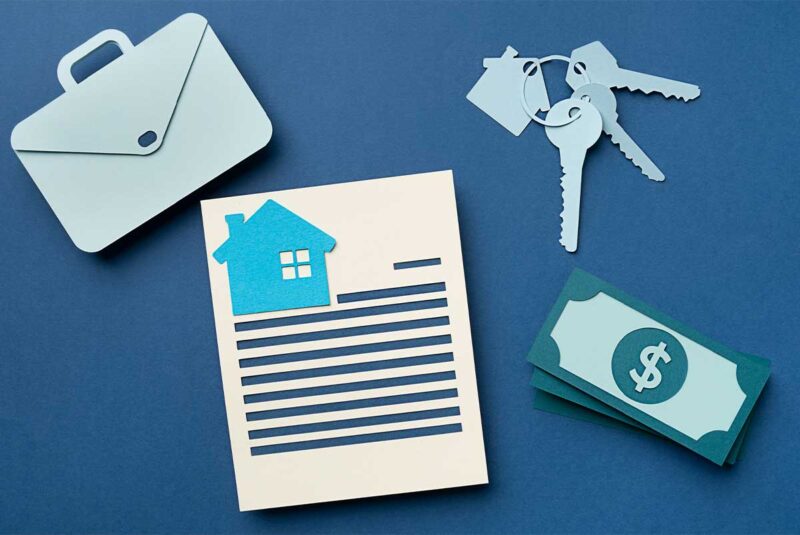Ready To Buy a Home?
Get Approved to Buy a Home
Rocket Mortgage® lets you get to house hunting sooner.
When you apply for a loan to buy a home, lenders use mortgage underwriting to decide if they want to do business with you. During this process, your personal and financial information is evaluated to determine whether you can afford the loan.
It’s the last step in the application process. Ideally, it ends with a go-ahead from the mortgage underwriter to close on the house. (And you celebrate your win with a few pics of the new home on Instagram.)
Knowing the ins and outs of the mortgage underwriting process can give you an advantage that gets those house keys in your hand.
Let’s go behind the scenes to learn what happens after you hand over your stack of financial documents, and your mortgage application is sent to underwriting.
What Is Mortgage Underwriting?
When your mortgage goes to underwriting, an underwriter for your lender pulls out a big, old calculator and a magnifying glass to get a closer look at your financial profile. The underwriter verifies your income, assets and debts (among other things) and decides if your application is creditworthy.
Up to this point, you’ve likely been dealing with a mortgage loan officer who guided you through the initial application process. And, no doubt, the loan officer had you submit a detailed history of your finances, including pay stubs and bank statements.
Once all your paperwork is submitted, your application is ready to move down the line to the underwriter.
What Does a Mortgage Underwriter Do?
A mortgage underwriter reviews your loan application to see if it meets the lender’s standards. They verify the information you’ve given them and look for anything that doesn’t add up (pun intended).
Then, the number-crunching begins. A mortgage underwriter is going to answer:
- How much debt do you have in relation to income? (Your debt-to-income (DTI) ratio)
- Do you have an adequate down payment and enough money saved, in case you need it?
- How much is the property worth compared to the money you want to borrow? (Its loan-to-value (LTV) ratio)
- Based on your credit history, how likely is it that you’ll be able to make your monthly mortgage payments?
The underwriter thoroughly vets your application and flags issues that may require further investigation.
The goal is to answer one question: Can you be relied on to make your mortgage payments?
How Does the Mortgage Underwriting Process Work?
Okay, so how does the process play out? Well, the loan underwriting process can happen in a couple of ways:
- Automated underwriting: Automated reviews work best for simple, straightforward applications. Your information is entered into a software program that runs a check based on algorithms and computer modeling. The final decision is always reviewed IRL.
- Manual underwriting: Some lenders have people do the underwriting. This is especially helpful for borrowers with complex or unique financial situations. You can explain any potential red flags, like drastic changes in income or past issues with debt. And you get a chance to explain why your income is irregular, which can happen with mortgage applications for self-employed borrowers.
- Combination of automated and manual underwriting: Sometimes an algorithm can’t do it all, and lenders will use a combination of automated underwriting and manual underwriting to determine loan eligibility. It all depends on your financial situation and the type of loan you’re applying for.
What do these methods of underwriting have in common? They all use the same criteria to evaluate your mortgage loan application.
5 Steps to the Mortgage Underwriting Process
Once the mortgage processor makes sure your paperwork is organized and all the needed info is there, you’re ready to start the underwriting process.
Let’s pop the hood on this process and see what mortgage underwriting looks like up close and personal.
1. Your application is sent to the underwriter
The mortgage underwriter needs plenty of paperwork to make a final decision. Every lender has different requirements, but expect to spend some quality time pulling up documents, like tax returns, bank statements, pay stubs and any contracts related to your purchase.
2. Underwriting begins
With your file in hand, the underwriter will dig into what’s commonly known as the “5 C’s of credit”:
- Character: How reliable are you when it comes to paying off debt? Your past credit history – including student loans, car loans, credit cards and lines of credit – is scrutinized. The underwriter wants to know how much you owe and how well you’ve met your financial obligations.
- Capacity: This refers to your ability to repay the mortgage. Do you have a stable job that provides enough income to pay off your loan? The underwriter figures out your debt-to-income (DTI) ratio by dividing your total monthly debt by your gross monthly income. Each lender has a maximum DTI they’re willing to accept.
- Collateral: Because your home is collateral for the mortgage loan, an underwriter needs to make sure the property you’re buying is worth the amount you want to borrow. If the home isn’t worth the amount they lend you, the lender can’t get their investment back if you can’t make your payments. This is where the home appraisal – which determines the value of the property you’re buying – comes in.
- Capital: How much do you have in your banking and retirement accounts? And how much of it are you using to make the down payment? A healthy nest egg shows that you can manage your money. It also signals that you have enough money saved to deal with any unexpected financial surprises.
- Conditions: The underwriter determines whether you meet the lender’s conditions for eligibility. They also consider the potential impact of conditions outside of the borrower’s control, like a poor job market or downturn in the economy, that may impact your ability to repay the loan.
3. The property is appraised
Mortgage underwriting involves a professional appraisal of the property you want to buy. The lender wants to make sure that you’re not applying to borrow more money than the property is worth. The appraisal puts a value on the home based on its size, condition, features and location.
The underwriter uses the appraisal to figure out the property’s loan-to-value (LTV) ratio. The LTV is the mortgage loan amount divided by the appraised property value. Lenders have an LTV threshold that they will accept on a mortgage. Typically, lower LTVs are preferred.
Enter, your real estate agent. Your agent can help you negotiate if the property’s price needs to come down so you can meet your lender’s requirements and appraisal value.
4. The title search is completed
The title search ensures that the property is free and clear for the borrower to buy, confirming that:
- The seller is the rightful owner and can legally sell it.
- There are no outstanding taxes or liens.
- There are no claims on the property by other parties.
5. The underwriter’s decision
Once the mortgage underwriter has considered all these factors, they’ll have a good sense of how risky it might be to lend you money. Even if there is a concern over one part of your application, another part may be strong enough to make up for it.
There are three possible outcomes after underwriting is complete:
- You’re approved! The mortgage underwriter has given you the proverbial thumbs up. You are good to close on the house. Break out these emojis: 🎉🎉🎉 in excited text messages to family and friends! You’ve earned it.
- Your application is denied. If there were concerns about your ability to repay the loan because of debt, income or loan-specific eligibility requirements, the underwriter can deny the application. Find out why your application was denied, so you can try and fix the situation for future applications. The moral of the story is that you don’t have to give up on your dream of owning a home.
- Your application is pending. When a decision is on hold, something has been flagged or the pieces don’t quite fit together in your application. The underwriter will request additional information or verifications before making a final decision.
How Long Does Mortgage Underwriting Take?
Mortgage underwriting can take anywhere from a few days to a week if everything is in order. Otherwise, it could take several weeks.
Obsessively checking for three dots in your text message chat with your lender may ease your anxiety, but you’ll need to come to terms with the fact that there are a lot of variables involved in underwriting, including how complex your financial picture is. And depending on how busy the underwriter is, if they’re swamped under a pile of applications, you’ll have to wait … patiently.
Get 2 Steps Closer to a Smooth Underwriting Process
1. Dodge the don’ts
Underwriters like stability. Generally, underwriters don’t like new jobs, late bills, big purchases, new credit accounts and even closed credit accounts.
Stay chill or put your credit cards on (or in) ice. Resist spending on big-ticket items, whether it’s a sofa you know would look great in your new home or a holiday getaway with bae or the brunch squad.
Changes in your financial situation after you submit your application can cause the underwriter to delay or even deny your mortgage application.
Don’t:
- Spend large sums of money: Taking on additional debt changes your debt-to-income ratio. Even if you pay with cash instead of using credit, a large withdrawal from your savings is a decrease in your savings – and that doesn’t look good to an underwriter.
- Leave your job: Unless you’re being promoted, now is not the time to change anything related to work. If you can, hold off on leaving, starting a new business or changing career paths.
- Miss bill payments: Did you miss a few payments in the past or a few payments during the excitement of buying a new home? Missed payments affect your credit score – and not in a good way. A drop in your score can cause your underwriter to reevaluate your financials.
- Apply for new credit: Mortgage lenders will take note if new debt crop ups while you’re also applying for a loan from them.
- Change bank accounts: Keep your assets where they are. Don’t close accounts or open new ones. Lenders want to know your money is safely and reliably tucked away. Any changes to your banking information may cause the underwriter to backtrack on the process.
2. Do the do’s
If your lender reaches out to you during the underwriting process for more information or paperwork, here’s what you do: You always respond quickly. And you always respond honestly.
Keep your application moving along by responding to questions from the lender ASAP.
- Always be honest. When it comes to mortgages, there is no dewy, rose-colored filter that can beautify your financial situation. Lenders will figure out if things are sus. And misrepresenting information can get you into legal trouble down the road.
- Make a down payment. Put as much cash toward the home purchase as you can. The more equity you have in your mortgage, the more attractive your application is.
Your Mortgage, Unlocked
Want to crack the code on getting approved for a mortgage? The secret lies in the financial profile you’ve been building since you started house hunting (or even before then).
Once you’ve submitted your mortgage application, it’s your job to try not to make any major changes to the financial profile that got your lender interested in doing business with you. It’s also your job to avoid unnecessary delays and to be responsive and honest with the lender.
Get approved to buy a home.
Rocket Mortgage® lets you get to house hunting sooner.
The Short Version
- A mortgage underwriter decides if your loan application gets a thumbs up or a thumbs down
- Your income, savings, debt and credit history all come into play
- Creditors can opt for manual or automatic underwriting or a combination of both




